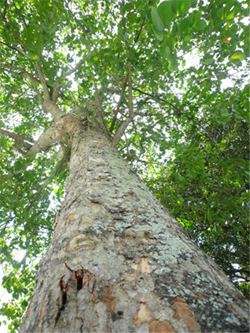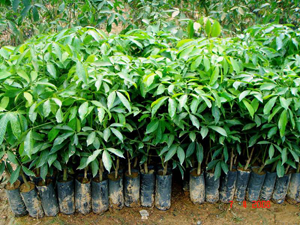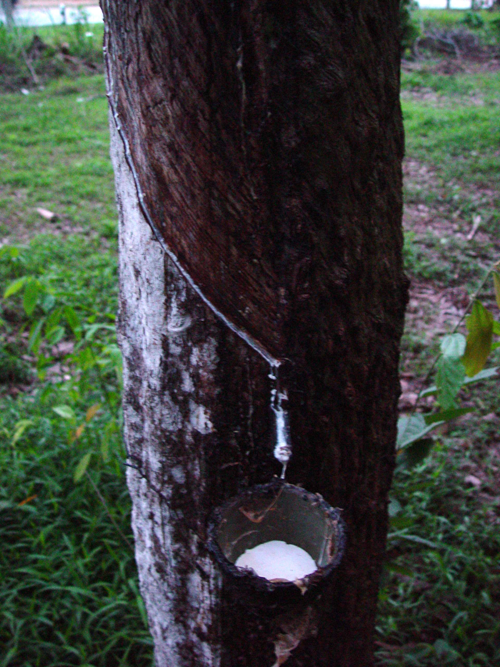|
 |
 |
| Rubber Plantation |
Rubber Tree |
Varieties
Tjir 1, PB 86, BD 5, BD 10, PR 17, GT 1, RRII 105, RRIM 600, PB 28/59, PB 217, PB 235, RRIM 703, RRII 5, PCK-1, 2 and PB 260
Soil and climate
It requires deep and lateritic fertile soil with an acidic pH of 4.5 to 6.0 and highly deficient in available phosphorous. Tropical climate with annual rainfall of 2000 – 4500 mm is suited for cultivation. Minimum and maximum temperature should be ranged from 25 to 34°C with 80 % relative humidity is ideal for cultivation. Regions prone to heavy winds should be avoided.
Season
June – July is optimum for cultivation
Method of propagation
Propagated by green budding, brown budding and crown budding.
Nursery: Bed size: 60-120 cm width and of convenient length.
Spacing: Seedling stumps – 23 x 23 cm, 30 x 30 cm and 34 x 20 cm
Budded stumps – 30 x 30 cm
Stump budding – 60 x 60 cm
Bud wood nursery – 60 x 90 cm or 60 x 120 cm.
Seedling Nursery:
Manuring: Basal -2.5 t/ha of FYM and 350kg/ha of Rock Phosphate.
1.5 – 2 months after planting –10:10:4:1.5 NPKMg mixture -2500 kg/ha.
Urea @550 kg /ha -3 to 3.5 months.
 |
Seedlings in Nursery |
Planting: Pit size of 1 m3 are dug and filled up with top soil and compost
Planting material |
Spacing (m) |
Population / ha |
Budded plants |
Hilly areas |
6.7 X 3.4 |
445 |
Plains |
4.9 X 4.9 |
420 |
Seedlings |
Hilly areas |
6.1 X 3.0 |
539 |
Plains |
4.6 X 4.6 |
479 |
In situ sowing: Germinated seeds are sown in situ in the pits. Healthy ones are retained and
the others removed.
Manuring
For immature rubber trees at pre-tapping stage
Apply 12 kg of compost or FYM and 120 g of rock phosphate in each pit before planting. Apply 10:10:4:1.5 NPK andMg as per schedule given below:
Months after planting |
Period of application |
Quantity per plant |
10:10:4 |
12:12:6 |
3 |
September/October |
225 g |
190 kg |
9 |
April/May |
445 g |
380 kg |
15 |
September/October |
450 g |
380 kg |
21 |
April/May |
450 g |
480 kg |
27 |
September/October |
550 g |
480 kg |
33 |
April/May |
550 g |
380 kg |
39 |
September/October |
450 g |
380 kg |
Apply 400 kg of mixture/ha in 2 doses, once in April/May and another in September/October from the 5th year till the tree is ready for tapping.
Matured rubber trees under tapping
For matured rubber trees under tapping apply NPK 10:10:10 grade mixtures at the rate of 900 g/tree (300 kg/ha) every year in two split doses. Add 10 kg commercial Magnesium sulphate for every 100 kg of the above mixture if there is magnesium deficiency.
Aftercultivation
Growing of cover crops, incorporation of cover crops and weeding are important operations. Pueraria phaseoloides, Calopagonium muconoides, Centrosema pubescens and Desmodium evalifolium are common cover crops.
Tapping
S/2 d/2 |
(half spiral, alternate day for 6 months and rested for 3 months) |
100% Intensity |
S /2 d/2
6m /9 |
(half spiral, alternate day for 6 months and rested for 3 months) |
67 intensity |
S /2d/3 |
(half spiral, third day) |
67 intensity |
S/2 d/3
1m/2 |
(half spiral, daily for one month and rested for next
month) |
100% intensity |
S /1 d/4 |
Full spiral, fourth day |
100% intensity |
V /2 d/2
12m/16 |
Half circumstances and cut alternate day for 12
months and rested for the next 4 months |
75% intensity |
Ethrel treatment
Ethrel is recommended to increase latex yield of trees. It is applied at 5% a.i. concentration with a brush below the tapping cut to a width of 5 cm after light scraping of the outer bark. The first application may be done after a drought period preferably after a few pre-monsoon showers and subsequent applications may be done in September and November. However, continuous application of Ethrel is not recommended for periods of more than 3 years at a stretch.
Tapping panel dryness (Brown bast)
Syndrome characterized by prolonged dripping of latex with the gradual decline in volume yield, pre coagulation of latex and partial or complete drying of tapping area (10-25 per cent).
Control
Reduce tapping intensity or give a tapping rest for 3 to 12 months.
 |
Latex Collection |
Plant protection
Pests
Scale insect
When severe infestation is noticed, spray Organophosphorus insecticides like malathion 50 EC 2 ml/lit.
Mealy bug
Spray fish oil rosin-soap 25 g/lit. Release Austalian lady bird beetle, Cryptolaemus montrouzieri @ 10/tree.
Termite (White ant)
Drench the soil at the base of affected plants with Chlorpyriphos 20 EC 2 ml/litre.
Cockchafer grub
Drench soil at the base of plants in the affected area with the solution of Chlorpyriphos 20 EC 2 ml/litre.
Mites
Spray Sulphur 50 WP at 2 g/lit or spray Dicofol 18.5 EC 2.5 ml/lit.
Diseases
Abnormal leaf fall
Prophylactic spraying on the foliage prior to the onset of South-West monsoon with, Bordeaux mixture 1% at 4000 - 5000 lit/ha using high volume sprayers.
Oil based Copper oxy chloride using low volume sprayer or through aerial application.
Two rounds of spray using about 17 to 22 lit of fungicide oil mixture per ha per round (1:6 proportion) at 10 to 15 days interval (or) a single round of spray with about 30 - 37 lit of fungicide oil mixture per ha (1:5 proportion).
Secondary leaf fall
The control measures suggested for abnormal leaf fall will check this disease also.
Powdery mildew
Dusting during the defoliation period commencing from the bud break in about 10% of the trees, giving 3 to 5 rounds at weekly to fortnightly intervals before 10.00 a.m. using 11 to 14 kg 325 mesh fine Sulphur dust per round per ha. Sulphur dust can be mixed with talc in the proportion of 7:3. Wettable sulphur (1 kg in 4000 lit of water) is also effective in nurseries and for young plants as a spray.
Bird's eye spot
Repeated sprayings with Bordeaux mixture 1% or Mancozeb or Copper oxychloride 0.2%. Provide shade in nursery. Give balanced manuring to increase tree vigour.
Leaf spot
Spray 1% Bordeaux mixture or 0.2% Mancozeb, or 0.1% Carbendazim at fortnightly intervals.
Pink disease
Frequent tree to tree inspection should be done during July – September period for detecting the infected trees and application of Bordeaux paste in the early stages upto 30 cm above and below the affected region. In advanced cases apply Bordeaux paste and when it dries up scrape off the superficial mycelium and damaged bark and apply Bordeaux paste once again. Prune off and burn the dried up branches after disinfecting by Bordeaux spraying.
Patch canker or Bark cankers
The affected region may be scraped to remove all the rooting bark and the coagulated rubber and the wound washed well with Dithane M 45 @ 0.75 %. When the fungicide dries up apply wound dressing compound.
Dry rot, Stump rot, Collar rot or Charcoal rot
Clean up affected areas, by washing with Carbendazim (0.1%) solution. Scrape out the fructifications. Affected bark and wood show black lines. Wash the wound again with fungicide solution. When it dries up apply a wound dressing compound. Avoid accumulation of rubber at the base of the trees.
Brown root disease
Open up the root system. Completely killed and dried roots may be traced and pruned. Partially affected and healthy roots washed withfungicide Carbendazim (0.1%) solution. When the fungicide dries up, a thin coating with a wound dressing compound may be given. Refill the soil and drench the base with fungicide solution.
Yield
Rubber yield steeply increases year by year, reaching a peak after 14 years of planting. In South India, the annual yield of rubber is 375 kg/ha from seedlings trees, whereas budded plants yield 800 - 1000 kg/ha. |




